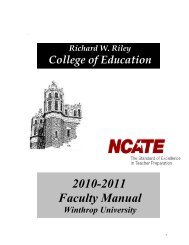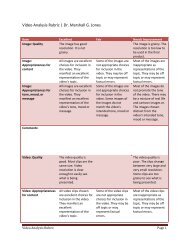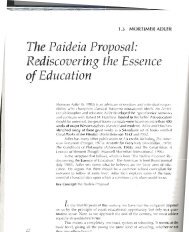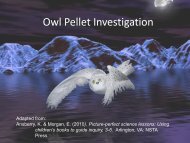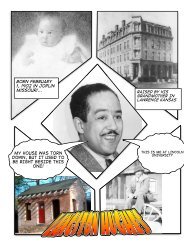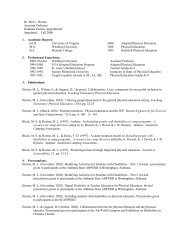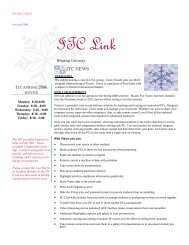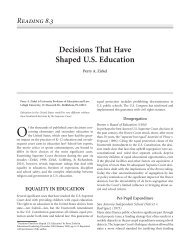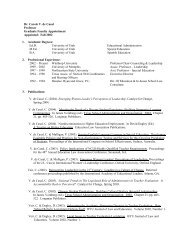incidences of bullying among children - PAWS
incidences of bullying among children - PAWS
incidences of bullying among children - PAWS
Create successful ePaper yourself
Turn your PDF publications into a flip-book with our unique Google optimized e-Paper software.
4 THE TEACHERS, SCHOOLS, AND SOCIETY READER<br />
clear that such behavior is unacceptable. Teachers can show<br />
the bully alternate ways to talk, interact, and negotiate; at<br />
the same time, they can encourage victims to assert themselves.<br />
By doing so, the teacher is showing the bully and the<br />
victim that action is being taken to stop the <strong>bullying</strong>.<br />
Acting promptly can prevent the <strong>bullying</strong> from escalating.<br />
When interacting with <strong>children</strong> on a one-on-one basis,<br />
teachers should provide encouragement that acknowledges<br />
specific attributes, rather than dispensing general praise, approval,<br />
or admiration (“I am so glad that you have done a<br />
great job; it is wonderful; yours is one <strong>of</strong> the best projects”)<br />
that may appear to be contrived. Expressions <strong>of</strong> specific encouragement<br />
(“You seem to be pleased and very interested<br />
in your project, and it appears you have worked on it for<br />
many days and used many resources to find answers to your<br />
questions”), as opposed to general praise, are descriptive,<br />
sincere, take place in private, focus on the process, and help<br />
<strong>children</strong> to develop an appreciation for their efforts and<br />
work. While developing <strong>children</strong>’s self-esteem is a worthwhile<br />
goal, false praise may instead promote narcissism and<br />
unrealistic self-regard. Teachers should avoid encouraging<br />
<strong>children</strong> to think highly <strong>of</strong> themselves when they have not<br />
earned it (Baumeister, 2001; Hitz & Driscoll, 1988).<br />
Additional long-term strategies may include encouraging<br />
<strong>children</strong> to resolve their own problems and using peers<br />
to mediate between bullies and their targets. Furthermore,<br />
teachers can spend time helping <strong>children</strong> to form ties with<br />
peers who can <strong>of</strong>fer protection, support, security, and<br />
safety, thus helping to reduce <strong>children</strong>’s exposure to <strong>bullying</strong><br />
(Kochenderfer & Ladd, 1997; Ladd, Kochenderfer, &<br />
Coleman, 1996).<br />
SUMMARY<br />
Bullying and teasing are an unfortunate part <strong>of</strong> too many<br />
<strong>children</strong>’s lives, leading to trouble for both bullies and their<br />
victims. Children who are bullied come to believe that<br />
school is unsafe and that <strong>children</strong> are mean. They may develop<br />
low self-esteem and experience loneliness. Children<br />
who continue to bully will have difficulty developing and<br />
maintaining positive relationships. A comprehensive intervention<br />
plan that addresses the needs <strong>of</strong> the school, the<br />
classroom, teachers, <strong>children</strong>, and families can be developed<br />
and implemented to ensure that all <strong>children</strong> learn in a<br />
supportive and safe environment.<br />
REFERENCES<br />
Batsche, G. M., & Kn<strong>of</strong>f, H. M. (1994). Bullies and their victims:<br />
Understanding a pervasive problem in the<br />
schools. School Psychology Review, 23, 165–174.<br />
Baumeister, R. (2001). Violent pride: Do people turn violent<br />
because <strong>of</strong> self-hate, or self-love? Scientific<br />
American, 284, 96–101.<br />
Bushman, B. J., & Baumeister, R. F. (1998). Threatened egotism,<br />
narcissism, self-esteem, and direct and displaced<br />
aggression: Does self-love or self-hate lead to violence?<br />
Journal <strong>of</strong> Personality and Social Psychology, 75, 219–229.<br />
Frieman, M., & Frieman, B. B. (2000). Reducing harassment<br />
in elementary school classrooms using high school mentors.<br />
(ERIC Document Reproduction Service No. ED<br />
439 797).<br />
Froschl, M., & Sprung, B. (1999). On purpose: Addressing<br />
teasing and <strong>bullying</strong> in early childhood. Young<br />
Children, 54, 70–72. Gropper, N., & Froschl, M. (1999).<br />
The role <strong>of</strong> gender in young <strong>children</strong>’s teasing and <strong>bullying</strong><br />
behavior. Montreal, Canada. (ERIC Document<br />
Reproduction Service No. ED 431 162). Hitz, R., &<br />
Driscoll, A. (1988). Praise or encouragement? New insights<br />
into praise: Implications for early childhood<br />
teachers. Young Children, 42, 6–13. Katz, L. G. (1993).<br />
Distinctions between self-esteem and narcissism:<br />
Implications for practice. Urbana, IL: ERIC<br />
Clearinghouse on Elementary and Early Childhood<br />
Education. Katz, L., & Chard, S. (2000). Engaging <strong>children</strong>’s<br />
minds: The project approach (2nd ed.). Stamford,<br />
CT: Ablex. Kochenderfer, B. J., & Ladd, G. W. (1996).<br />
Peer victimization: Cause or consequence <strong>of</strong> school<br />
maladjustment? Child Development, 67, 1305–1317.<br />
Kochenderfer, B. J., & Ladd, G. W. (1997). Victimized<br />
<strong>children</strong>’s responses to peers’ aggression: Behaviors associated<br />
with reduced versus continued victimization.<br />
Development and Psychopathology, 9, 59–73.<br />
Ladd, G. W., Kochenderfer, B. J., & Coleman, C. (1996).<br />
Friendship quality as a predictor <strong>of</strong> young <strong>children</strong>’s<br />
early school adjustment. Child Development, 67,<br />
1103–1118.<br />
Lambert, E. B. (1999). Do school playgrounds trigger playground<br />
<strong>bullying</strong>? Canadian Children, 42, 25–31.<br />
Lickona, T. (2000). Sticks and stones may break my bones<br />
AND names WILL hurt me. Thirteen ways to prevent<br />
peer cruelty. Our Children, 26, 12–14.<br />
Loeber, R., & Dishion, T. J. (1984). Boys who fight at home<br />
and school: Family conditions influencing cross-setting<br />
consistency. Journal <strong>of</strong> Consulting and Clinical<br />
Psychology, 52, 759–768.<br />
Morris, V. G., Taylor, S. I., & Wilson, J. T. (2000). Using <strong>children</strong>’s<br />
stories to promote peace in classrooms. Early<br />
Childhood Education Journal, 28, 41–50.<br />
Noll, K., & Carter, J. (1997). Taking the bully by the horns.<br />
Reading, PA: Unicorn Press.<br />
Olweus, D. (1991). Bully/victim problems <strong>among</strong> school<strong>children</strong>:<br />
Basic facts and effects <strong>of</strong> a school based intervention<br />
program. In D. J. Pepler & K. H. Rubin (Eds.),



